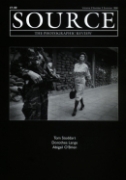Wider Angles
'Wider Angles' by Helen Maginn was at the Old Museum Arts Centre, Belfast, 1996
Review by Linda McClelland
Issue 8 Summer 1996
View Contents ▸
There is always the question of ownership in a collaborative body of work. For example, how much say did the photographer have in the initial stages and on completion of the project? When work is commissioned other questions arise such as who has commissioned it, for what reasons and how was the photographer selected? Equally, where will the resulting work be displayed and why this particular venue?
To view Helen Maginn's exhibition raises all these questions.
Castlereagh Borough Council commissioned the project which the women of Greenway Centre had instigated in collaboration with a writer and photographer. Maginn was most likely chosen because of her previous work which was documentary in genre and often portraying 'women based issues' with sensitivity and humour (for example 'A Day in the Life of Finbar Maginn'). Initially the work was for display in the centre itself with twelve images selected for a calendar. OMAC not only took the work on board but extended the initial exhibition period. This was an appropriate venue as OMAC has a policy of providing a focus for artistic activity across all art forms with particular emphasis on individuals and groups who might previously have been excluded from an active participation in the arts.
Maginn worked with a large group of women over a three month period at the Greenway Women's centre in East Belfast in a collaborative attempt to depict these women's lives, culture, aspirations and their participation in the wider community.
The women also worked with a writer. Sometimes the text inspired the images and sometimes the images inspired the text. Any of which begs the question were writer and photographer merely facilitators? I think not. The text may have been made of the women's own words but the copyright for the photographs rests with Maginn. She was the eye behind the camera, the 'Operator', the women the 'Referent' and we the 'Spectator'. The photographer has the power to exploit her subject even though she has willing, if unaware, accomplices. Maginn does not abuse this power - her portraits are sympathetic, strong yet often humorous. We see a bird's eye view of a woman lying under a car in overalls, obviously mending it. Only the legs protrude, but on the end of each foot is a stiletto heeled shoe - mighty glamorous! Another image portrays a large group of swimsuited women up to their waists in water performing exercises with arms waving - a Busby Barclay scene where all the actresses are over sixty.
These results could have become sentimentalised, overly romantic and idealistic. Alternatively they could have been soul searching, angst-ridden and overtly feminist. Maginn has avoided either pitfall and emerged with work which is positive, fresh and optimistic, presumably an accurate depiction of the women themselves. Traditional skills such as bread making are balanced with the technology of the computer and car maintenance with ironing. A bird's eye view of a roundabout indicates paths to be taken. Irish dancers whirl furiously, caught up in tradition or moving too quickly to take stock. They seem to be part of a never-ending circle. The teenage girl in the Doc Marten boots pushes herself on a child's swing, wistful and reluctant to grow up. Another applies make-up - who is this ritual for?
The compositions are inviting and inventive, often tightly cropped to create intimacy. But there are more than visual stimuli at work, as sounds and smells leap from the photographs for those who wish to tune in - dough thuds onto a floured surface, steam hisses from an iron, there is the odour of chlorine, car grease and freshly laundered clothes competing with the urgent flap of dancing dresses. The exhibition concludes with a kind of Minor White equivalents; images of waterfalls, plants, branches, Mother Earth, a continuity. These images express the quiet presence and power of nature. I believe all interested parties were pleased with the outcome of this collaboration and rightly so. The correct balance was achieved between the accessible and the challenging. Such work deserves to be published in book format.
Other articles by Linda McClelland:






